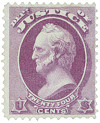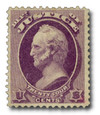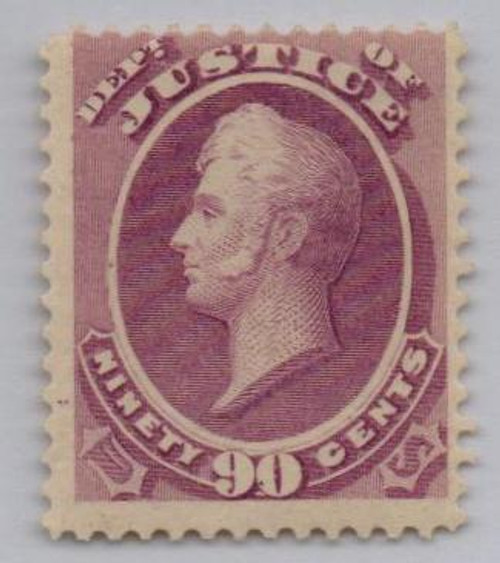
# O32 - 1873 24c Purple, Department of Justice, Scott, Hard Paper
1873 24¢ Scott
Official Stamp – Justice
Birth Of General Winfield Scott
Born to an American Revolution veteran, Scott attended the College of William and Mary before studying law. He was admitted to the bar and briefly attempted to practice. But around the same time he had his first taste of military experience. He served as a corporal of the cavalry with the Virginia militia near Petersburg in 1807 as part of the Chesapeake–Leopard Affair.
The following year, Scott met the Secretary of War, Henry Dearborn, and President Thomas Jefferson. After this meeting he was commissioned a captain in the Light Artillery just before he turned 22. It was during this time that he earned the nickname “Old Fuss and Feathers” because of the discipline of his troops and his elaborate uniforms.
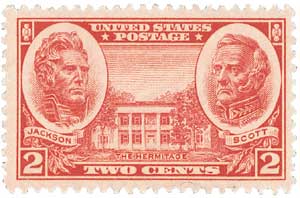
Scott was promoted to lieutenant colonel and served in the Niagara campaign during the War of 1812. He led the unsuccessful landing during the Battle of Queenston Heights and was held prisoner by the British. Scott was released a year later in a prisoner exchange.
After being promoted to colonel in 1813, Scott commanded the Americans in the capture of Fort George in Ontario, Canada. He was wounded during the battle, but his men were still able to overpower the British. This is considered one of the best-planned and executed battles of the War of 1812.

Scott attained the rank of brigadier general in March 1814. He led his men to victory in the Battle of Chippawa, and they fought courageously at the bloody Battle of Lundy’s Lane. Brigadier General Scott was severely wounded and spent the rest of the war recovering.
After the War, Scott prepared the first standard drill regulations of the U.S. Army. He visited Europe to learn French military tactics and translated French military manuals into English.
In 1832, Scott was put in command of American troops in the Cherokee Nation. The Supreme Court had ruled the Cherokees had the right to self-rule, but President Andrew Jackson ignored the decision. The Treaty of New Echota was signed by a small group from the tribe but was never approved by the Cherokee National Council. It gave all territory to the federal government and ordered all residents to move to land west of the Mississippi.
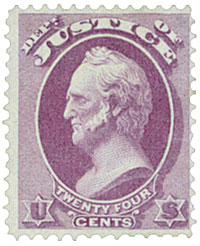
Scott supervised the removal under orders from President Martin Van Buren. He began on May 26, 1838, with the Cherokees in Georgia. Scott tried to treat the people humanely, saying acts of cruelty were “abhorrent to the generous sympathies of the whole American people.” The Cherokees were put in stockades, where over 4,000 died. The first group headed west in the middle of the summer, and many perished in the heat. Scott accompanied the next group in the autumn until he was called back to Washington from Nashville. This tragic part of American history is known as the Trail of Tears.
Winfield Scott was once again promoted, this time to major general and became commanding general of the U.S. Army on July 5, 1841. In the Mexican-American War, Scott proved himself worthy of his rank when he commanded his troops in an attack on Mexico City. On September 13, 1847, the city surrendered and Scott became military commander. He was well respected because of his fair treatment of the Mexicans.
Scott was a celebrated war hero when he returned to the United States. During the 1852 presidential election, the Whig Party nominated him over President Millard Fillmore. The party was divided over the slavery issue, and Democrat Franklin Pierce won the election. In 1855, Congress voted to give Scott the rank of lieutenant general, only the second man in U.S. history up to that time to receive this honor, the first being George Washington.
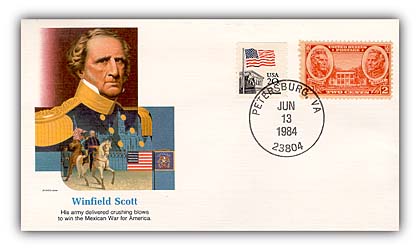
Commander Scott was 74 years old and in poor health when the Civil War began in 1861. Though his mind was still sharp, he could no longer lead his troops into battle. He asked Colonel Robert E. Lee, who Scott once called “the very finest soldier I’ve ever seen,” to take charge of the Army. When Virginia seceded from the Union, Lee resigned to fight for his home state. In the twilight of his career, the aging General Scott devised a plan that helped the North win the Civil War.
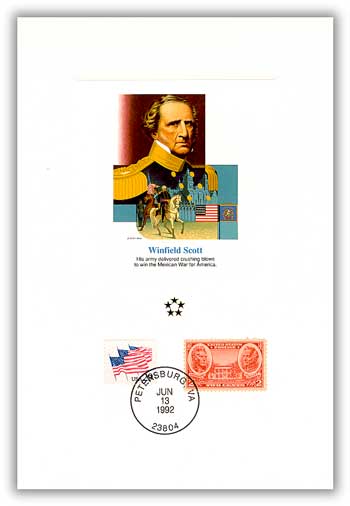
Many in the North, including the press, believed the war would be quickly won, but Scott knew it would be a long campaign. His plan was to cut off Southern supply routes by blockading ports and controlling the Mississippi River. The press named it the Anaconda Plan, and President Lincoln rejected it. Scott was forced to resign and was replaced by George McClellan. As the war continued longer than most had predicted, Scott’s Anaconda Plan was implemented and helped restore the Union.
1873 24¢ Scott
Official Stamp – Justice
Birth Of General Winfield Scott
Born to an American Revolution veteran, Scott attended the College of William and Mary before studying law. He was admitted to the bar and briefly attempted to practice. But around the same time he had his first taste of military experience. He served as a corporal of the cavalry with the Virginia militia near Petersburg in 1807 as part of the Chesapeake–Leopard Affair.
The following year, Scott met the Secretary of War, Henry Dearborn, and President Thomas Jefferson. After this meeting he was commissioned a captain in the Light Artillery just before he turned 22. It was during this time that he earned the nickname “Old Fuss and Feathers” because of the discipline of his troops and his elaborate uniforms.

Scott was promoted to lieutenant colonel and served in the Niagara campaign during the War of 1812. He led the unsuccessful landing during the Battle of Queenston Heights and was held prisoner by the British. Scott was released a year later in a prisoner exchange.
After being promoted to colonel in 1813, Scott commanded the Americans in the capture of Fort George in Ontario, Canada. He was wounded during the battle, but his men were still able to overpower the British. This is considered one of the best-planned and executed battles of the War of 1812.

Scott attained the rank of brigadier general in March 1814. He led his men to victory in the Battle of Chippawa, and they fought courageously at the bloody Battle of Lundy’s Lane. Brigadier General Scott was severely wounded and spent the rest of the war recovering.
After the War, Scott prepared the first standard drill regulations of the U.S. Army. He visited Europe to learn French military tactics and translated French military manuals into English.
In 1832, Scott was put in command of American troops in the Cherokee Nation. The Supreme Court had ruled the Cherokees had the right to self-rule, but President Andrew Jackson ignored the decision. The Treaty of New Echota was signed by a small group from the tribe but was never approved by the Cherokee National Council. It gave all territory to the federal government and ordered all residents to move to land west of the Mississippi.

Scott supervised the removal under orders from President Martin Van Buren. He began on May 26, 1838, with the Cherokees in Georgia. Scott tried to treat the people humanely, saying acts of cruelty were “abhorrent to the generous sympathies of the whole American people.” The Cherokees were put in stockades, where over 4,000 died. The first group headed west in the middle of the summer, and many perished in the heat. Scott accompanied the next group in the autumn until he was called back to Washington from Nashville. This tragic part of American history is known as the Trail of Tears.
Winfield Scott was once again promoted, this time to major general and became commanding general of the U.S. Army on July 5, 1841. In the Mexican-American War, Scott proved himself worthy of his rank when he commanded his troops in an attack on Mexico City. On September 13, 1847, the city surrendered and Scott became military commander. He was well respected because of his fair treatment of the Mexicans.
Scott was a celebrated war hero when he returned to the United States. During the 1852 presidential election, the Whig Party nominated him over President Millard Fillmore. The party was divided over the slavery issue, and Democrat Franklin Pierce won the election. In 1855, Congress voted to give Scott the rank of lieutenant general, only the second man in U.S. history up to that time to receive this honor, the first being George Washington.

Commander Scott was 74 years old and in poor health when the Civil War began in 1861. Though his mind was still sharp, he could no longer lead his troops into battle. He asked Colonel Robert E. Lee, who Scott once called “the very finest soldier I’ve ever seen,” to take charge of the Army. When Virginia seceded from the Union, Lee resigned to fight for his home state. In the twilight of his career, the aging General Scott devised a plan that helped the North win the Civil War.

Many in the North, including the press, believed the war would be quickly won, but Scott knew it would be a long campaign. His plan was to cut off Southern supply routes by blockading ports and controlling the Mississippi River. The press named it the Anaconda Plan, and President Lincoln rejected it. Scott was forced to resign and was replaced by George McClellan. As the war continued longer than most had predicted, Scott’s Anaconda Plan was implemented and helped restore the Union.



